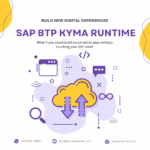What does it really mean to be agile in today’s cloud-native world? For businesses navigating complexity, agility is more than speed—it’s about building systems that are flexible, scalable, and prepared for what’s next.
Enter SAP BTP Kyma Runtime, a Kubernetes-based environment that enables developers to build, run, and extend applications with freedom—without breaking the architecture or compromising governance.
This blog explores how SAP BTP Kyma Runtime solves real-world problems of extensibility and custom development in modern enterprises. If you’re a developer, architect, or decision-maker wondering how to modernize without losing control, you’re in the right place.
Why We Need Kyma in the First Place
Let’s start by asking why. Why would a business already running SAP systems consider Kyma Runtime?
Here’s the problem: Businesses want to innovate fast, build cloud-native applications, and create extensions—without interfering with their core systems. Traditional approaches often result in fragile integrations or complex maintenance cycles.
Kyma was built to counter this.
SAP BTP Kyma Runtime offers:
- A fully managed Kubernetes runtime
- Support for microservices, event-driven architecture, and serverless functions
- Tight integration with SAP systems
- Open-source foundation with the Kyma Project, hosted by CNCF
This allows enterprises to extend SAP applications in a decoupled way, tapping into cloud-native tools without reinventing the wheel.
How It Works: A Quick Primer
Kyma is built on Kubernetes, but you don’t need to be a Kubernetes expert to use it. Think of it as a platform that:
- Accepts events from SAP S/4HANA, SAP SuccessFactors, and other systems
- Lets you build custom logic using microservices or functions
- Deploys those workloads securely in the cloud
- Uses APIs and subscriptions to stay loosely coupled
For example, when a sales order is created in SAP S/4HANA, that event can trigger a function deployed in Kyma to send notifications, update a dashboard, or even spin up an entirely new process. All of this without modifying your S/4HANA system.
Real-World Use Case: Extending SAP S/4HANA with Minimal Risk
Imagine you want to implement a customer review microservice for your e-commerce platform. You want it to:
- Collect reviews after a delivery is completed
- Integrate sentiment analysis
- Show ratings in your SAP Fiori app
Here’s what the old world looked like: custom code embedded in S/4HANA, dependencies scattered, hard upgrades, and long testing cycles.
Now, using Kyma:
- An event (“Delivery Completed”) is published by SAP S/4HANA.
- That event is captured in Kyma.
- A lightweight function calls an external sentiment API and stores the result.
- Your SAP Fiori app consumes the new data via a clean, documented API.
This microservice never touches the SAP core—yet it feels native. You evolve the system without disrupting it.
Developer Freedom Meets Enterprise Control
In Simon Sinek’s style, let’s bring this back to purpose.
Developers crave freedom. IT leaders demand governance. SAP BTP Kyma Runtime bridges that gap.
You get:
- Flexibility: Use any programming language or toolset
- Security: Managed runtime with SAP-grade controls
- Observability: Built-in logging, tracing, monitoring
- Compliance: Integrated with SAP Identity and Access Management
You don’t have to trade velocity for control. Kyma offers both.
Why Kyma Matters in the Bigger Picture of SAP BTP
SAP BTP isn’t just about tools—it’s about capabilities. Kyma fits into the broader story by enabling application extensibility in a clean, scalable, and future-ready way.
Think about it:
- Want to build new experiences on top of SAP data? Use Kyma.
- Need to connect to non-SAP systems via APIs? Use Kyma.
- Want to respond to events like customer creation or payment confirmation? Use Kyma.
It’s not just about building new apps—it’s about building them right.
Common Integration Patterns with Kyma
Let’s talk architecture. Here are common ways Kyma is used:
- Event-Driven Extensions
Extend SAP processes without modification by subscribing to events. - API Mashups
Combine SAP and third-party APIs to create unified experiences. - Custom Microservices
Run services that don’t fit into the SAP ecosystem but still need SAP data. - Serverless Functions
For simple business logic like notifications or calculations. - Machine Learning Inference
Run Python-based ML models triggered by SAP events, using Kyma as a runtime.
Each of these follows a modular, scalable, decoupled architecture that’s ideal for today’s digital demands.
Challenges and Best Practices
Kyma isn’t a silver bullet. It comes with a learning curve, especially for teams new to Kubernetes. But with SAP’s managed offering, much of the heavy lifting is removed.
Tips:
- Start small: Trigger a function with a simple event.
- Use SAP Event Mesh to route events reliably.
- Standardize API documentation for all custom services.
- Build governance into your CI/CD pipelines.
Final Thoughts: Build the Future Without Breaking the Past
Innovation is not about adding more—it’s about making what you already have work better.
SAP BTP Kyma Runtime gives organizations the means to evolve faster, build cleaner, and grow with confidence. You don’t have to choose between the old and the new. You can extend your legacy while building for the future.
That’s not just smart—it’s sustainable.











